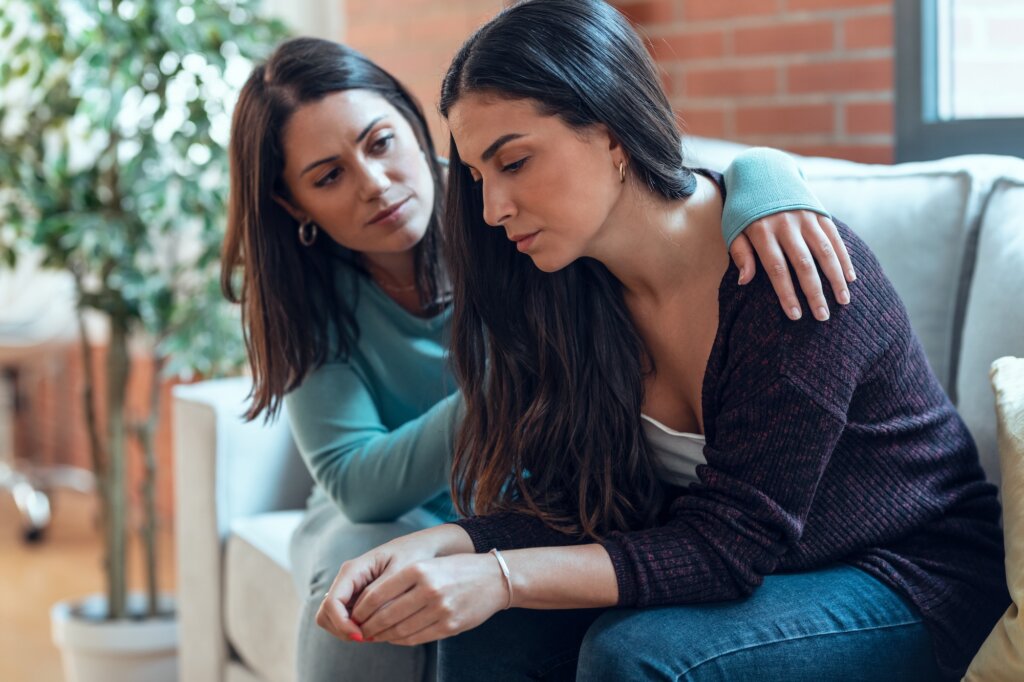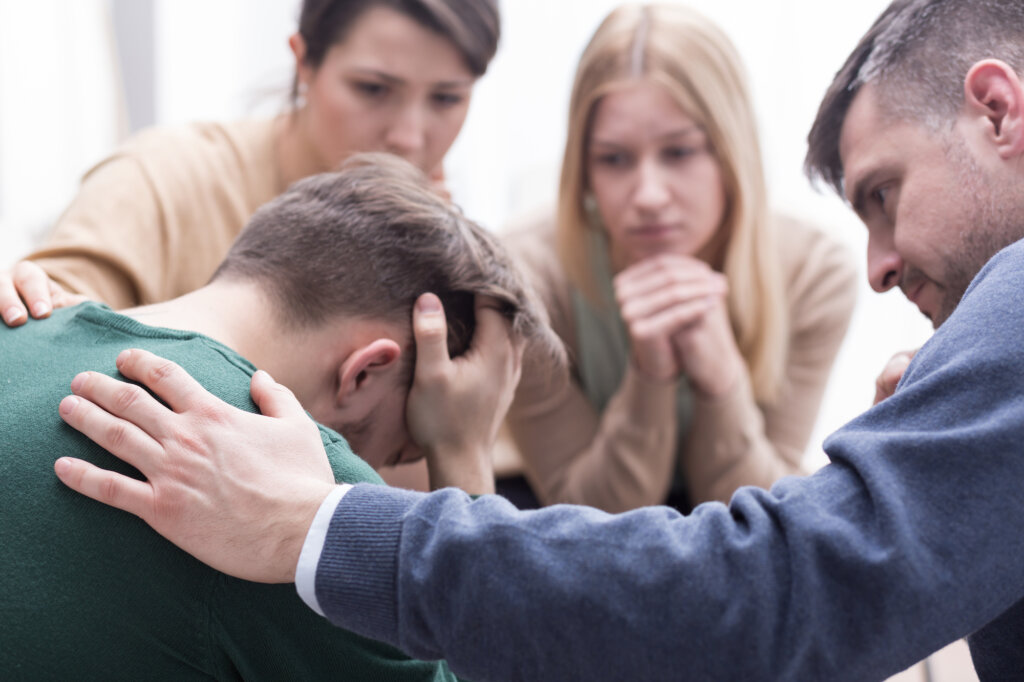Accompaniment in Grief


Written and verified by the psychologist Elena Sanz
Without a doubt, suffering a significant loss can be devastating. In fact, it sets numerous psychological and emotional processes in action for the bereaved, who, for a while, will experience a stage of readjustment. However, despite these painful and disconcerting moments, it’s good to know that they don’t suggest any disorder. Indeed, they’re just a natural reaction. For this reason, psychotherapy isn’t necessary, but accompaniment in grief can be beneficial.
This process isn’t necessarily carried out by professionals, but the support network close to the bereaved often plays a fundamental role. Accompaniment in grief means creating a safe space for the bereaved’s emotions, respecting their feelings of disorder and confusion, and simply being there for them. That said, it isn’t an easy task. In fact, we may often not know how to help a mourner. There are some useful guidelines.
Accompaniment in grief or psychotherapeutic intervention?
As we mentioned earlier, grief is a natural reaction of the body to the process of loss. It helps the bereaved work through the pain, integrate what’s happened into their history, and move on. The emotions that come with it may be unpleasant, but they’re not pathological. This is why, under normal circumstances, mourners can deal with their grief without requiring professional help.
That said, in certain cases, pathological grief appears. This occurs when the bereaved’s adaptation to loss is altered and excessively intense. Alternatively, they might suffer prolonged emotions or those that are repressed and masked. In such cases, the process of mourning becomes blocked and the individual is unable to move forward. Then, they require psychotherapy.
On the other hand, if their grief is non-pathological they don’t have to deal with it alone. In fact, the presence, company, and support of others are key to the bereaved person being able to transcend their loss and move on. However, there must be a series of characteristics and elements to the process of accompaniment in grief if it’s to be appropriate.

Accompaniment in grief
When dealing with a grieving person, it’s often difficult to know what to do or say. In effect, your own fears surface and become an obstacle toward you acting as support. In order to carry out effective accompaniment in grief, you must ensure you take the following factors into account:
Respect the grieving process
Most of us aren’t taught to deal with emotions. For this reason, seeing another person suffer is extremely uncomfortable and disturbing. In fact, so much so, that you may seek to do whatever it takes to make their pain go away.
However, accompaniment in grief means understanding that you can’t eliminate the pain of others, not by giving solutions or by trying to reason or intellectualize their situation. In these instances, the greatest support doesn’t involve getting them out of the darkness but accompanying them, with empathy and respect, while they go through it.
Show interest and focus on the bereaved person
Along similar lines, you must know how to escape your own reality if you’re to focus on the bereaved person. What matters is what they feel and need, not what you consider to be best.
Therefore, you have to understand when they want to speak and when they need silence. Or, when they’re looking for a hug and when they’d prefer to be alone. It means knowing how to read them so you can give them what they require, even if this isn’t what your instinct suggests.
Don’t judge them
If you’ve agreed to accompany another in their grief, you’re agreeing to walk the path with them, but not to lead them along it. After all, we’re all different and we all deal with loss in different ways. While it’s a human trait to evaluate and judge others, this doesn’t contribute anything positive. Each person is an expert on themselves and they know what works best for them. You mustn’t ever impose on them how they should feel or act. For this reason, you must exclude criticism from your behavioral repertoire.
Give them space for emotional expression
The venting of emotions is a fundamental task in mourning. For this, a safe space is needed. Indeed, it isn’t easy for the bereaved individual to open up to other people, and show themselves as vulnerable and devastated. But, if others welcome their feelings with openness and empathy, it’s easier for them.
Accompaniment in grief also consists of offering a safe space in which the mourner can express themselves without fear, and show their anger, sadness, or feelings of guilt. They need a space where they can tell their story and talk about their loved one as much as they need. This can be especially positive if they’re encouraged to remember how that person enriched their life and what legacies and teachings they provided them.
Provide concrete and specific support
When you’re accompanying someone in their grief, you might utter vague phrases like “I’m here for you, whatever you need” or “You can count on me.” However, it can be more beneficial to offer concrete and specific help. For example, helping them organize any necessary paperwork, procedures, or documents or preparing food to make sure that they eat well.
It’s also a good idea to take the initiative and call them to talk or propose some activities to distract them.
In effect, it’s essential that they feel the pain, but they must also find ways to temporarily forget it. It’s like a dance that wavers between getting closer and further away from the pain. It helps them process the situation and move on. For this reason, without forcing or being insistent or invasive, you should offer them minor activities that help them become active.

Professional accompaniment in grief
Once the needs of the bereaved person have been identified, they must be covered. This means having social support. Sometimes, friends and relatives carry out this work in a good way. On the other hand, they may not have the sensitivity, availability, or tools to follow it up correctly.
In these cases, it could be helpful to seek the support of a professional. Not strictly because the pain has become pathological, but because the mourner needs a safe space and empathic listening that they may not find in their environment. In this kind of scenario, the professional won’t be so concerned with setting guidelines. Instead, their role will be to accompany the natural human process of grief.
Some mourners find it useful to join support groups. In these environments, they find it easier to express themselves as they know that the others in the group understand and share their pain. Consequently, they feel identified and supported.
In short, accompaniment in grief is a process that can be carried out by different people and in various circumstances, as long as its principles are adopted. Respect, empathy, presence, and sensitivity to the needs of the bereaved are often the balm they need in these difficult situations.
All cited sources were thoroughly reviewed by our team to ensure their quality, reliability, currency, and validity. The bibliography of this article was considered reliable and of academic or scientific accuracy.
- López Fuentetaja, A. M., & Iriondo Villaverde, O. (2018). Sentir y pensar el duelo perinatal: acompañamiento emocional de un grupo de padres. Feeling and thinking the perinatal mourning: emotional accompaniment by a parent group. Revista Clínica Contemporánea, 9(e25), 1-24.
- Melguizo-Garín, A., Hombrados-Mendieta, I., & Martos-Méndez, M. J. (2020). La experiencia de un grupo de apoyo en el proceso de duelo de familiares de niños con cáncer. Un estudio cualitativo. Psicooncología, 17(1), 117.
- Moriconi, V., & Barbero, J. (2020). Guía de acompañamiento al duelo. Covid-19. http://www.cop.es/uploads/PDF/GUIA-ACOMPANAMIENTO-DUELO.pdf
- Vedia, V. (2016). Duelo patológico: factores de riesgo y protección. Revista Digital de Medicina Psicosomática y Psicoterapia, 6(2), 12-34. https://www.psicociencias.org/pdf_noticias/Duelo_patologico.pdf
This text is provided for informational purposes only and does not replace consultation with a professional. If in doubt, consult your specialist.








